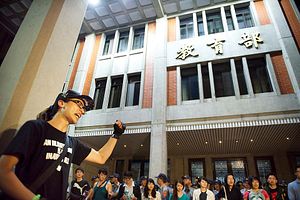One year ago, on August 3, 2015, tearful high school student representatives walked out of a meeting with then Minister of Education Wu Se-hwa, disappointed that their campaign to block implementation of new Sino-centric guidelines for social studies and history textbooks had come to naught.
Wu refused to suspend implementation of the new guidelines. He ordered that the new textbooks be printed, although he agreed that if teachers did not want to make the transition to the new textbooks yet, it would be possible to continue to use the old textbooks for the time being.
Anger against the new guidelines for the history textbooks had simmered under the surface since they were first approved by the Education Ministry in January 2014. The opposition focused both on the “black box” process followed by the Ma administration, as well as the substance of the new guidelines, which represented a major shift towards a Sino-centric perspective of Taiwan’s history.
According to many critics of the process, none of the members of the review committee tasked by the Ministry of Education to develop the new guidelines was a history specialist, while the committee’s convener, Professor Wang Hsiao-po of Hsin Shin University, was known as a fervent advocate of Taiwan’s unification with China.
On the substance, many critics pointed to major distortions in the new guidelines, such as the downplaying of the February 28, 1947 massacre of tens of thousands of Taiwanese, including teachers, students, and intelligentsia, by Chiang Kai-shek’s troops; the whitewashing of the subsequent White Terror repression (1947-1987); and the downplaying or even deletion of major events in Taiwan’s momentous transition to democracy (1979-1992).
The 2015 protests swelled between April and early August of that year, culminating in the storming of the Ministry of Education by hundreds of students, and a brief occupation of Wu’s own office by a group of students on July 23, 2015. It was also marked by the death of one of the student leaders, Lin Kuan-hua or “Dai Lin,” who ended his own life on his birthday, July 30, 2015. In his final Facebook posting, Lin wrote: “Wish me happy birthday. 8 5 12 16. I have only one wish: Minister [Wu] withdraw the curriculum guidelines.”
The tumultuous episode thus ended with the meeting between Wu and the student representatives on August 3, 2015. The students (and several accompanying history teachers) made eloquent appeals to call off or at least suspend the curriculum changes, and also criticized the opaque process. To no avail: the minister only made some superficial concessions.
The students generally felt their campaign had failed: the Ministry went ahead with the new guidelines and published the new textbooks. But at the same time, they had won a moral victory. They put the Ma government’s weirdly twisted view of history on the radar screen, both in Taiwan and overseas.
So, what is the situation now, one year later? The newly elected government of President Tsai Ing-wen moved very quickly. The day after the May 20 inauguration, the new minister of education, Pan Wen-chung, announced in a press conference that last year’s guidelines were rescinded. Pan said that a new review committee would be installed, and that new guidelines would be developed in an open and transparent process, in accordance with a resolution passed earlier by the Legislative Yuan and approved by the new Tsai government.
Pan also announced that the end-date of the current 12-year period national education system curriculum will be pushed back from 2018 to 2020, to give the review system ample time to come up with well thought out results.
In the subsequent weeks, the Ministry went to work and devised plans for a new broad-based review committee, consisting of scholars, history teachers, parents, and even four student members.
The convener of the 40-member committee is Professor Chuang Kuo-jung of National Chengchi University, who had served as secretary general of the Ministry of Education in the Chen Shui-bian administration and who holds a Ph.D. in law from the prestigious Ludwig Maximilians University of Munich in Germany, while the four student members — National Taitung University graduate student Wu Lu-te, National Chengchi University student Liao Hao-hsiang , Soochow University student Liu Chien-ping, and National Changhua Senior High School student Hsiao Chu-chun – had all been active in last year’s protest movement.
Supporting these four student members of the full review committee will be 18 other students who will serve in various subcommittees. Together, the 22 students represent a wide spectrum: half of them are high school students and the other half are in universities; there was a good balance between the genders, while several groups such as aborigines, handicapped, and children of foreign parents had special representation.
Thus, the picture after one year has gone through a major change in the positive direction: from a stubborn refusal by Minister Wu Se-hwa to budge in 2015 to an open and inclusive process under DPP Minister Pan Wen-chung in 2016.
There remains still much work to be done, but the efforts, sacrifices and persistence by the students one year ago have paid off. The process towards history textbooks that are faithful to Taiwan’s own unique history has been set in motion.
Gerrit van der Wees is a former Dutch diplomat. From 1980 through 2016 he also served as editor of Taiwan Communiqué, a publication based in Washington DC. He teaches history of Taiwan at George Mason University in Virginia.

































